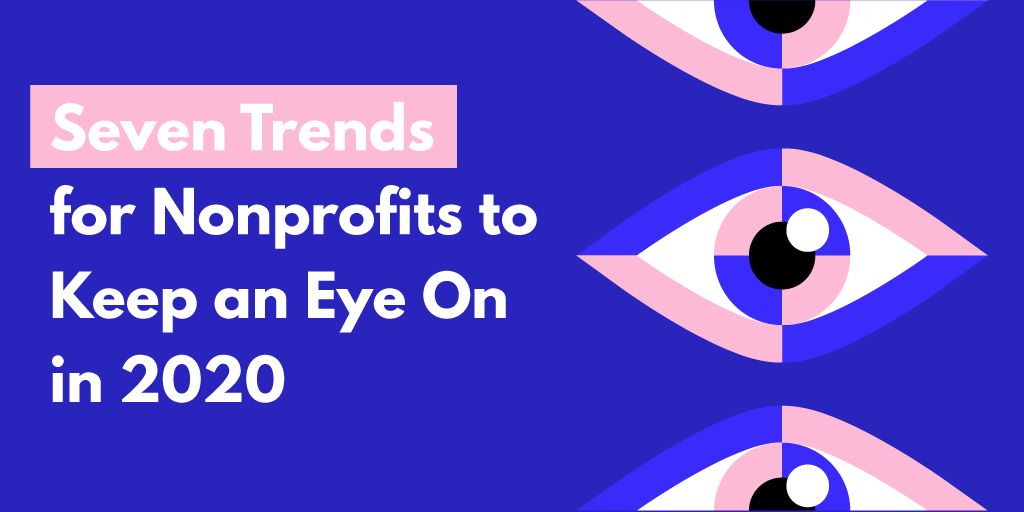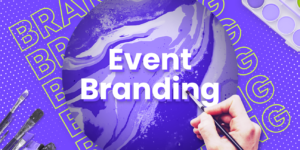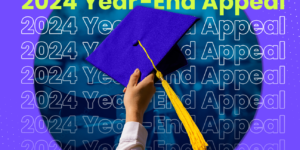If you’re like other fundraisers, you’re always looking for the next big thing. It’s important to stay on the cutting-edge if you want to raise more money so your nonprofit can achieve its goals and further its mission.
The fundraising landscape is evolving at a rapid pace. So, as we move into the new year, think about ways you can take advantage of these trends for nonprofits in 2020.

1. Social media and peer-to-peer
Today, nonprofits need a robust digital communications strategy to engage with their audience. This includes the obvious, like an effective email strategy and an engaging website.
And while those are crucial elements of any digital campaign, they just scratch the surface of what donors will expect from nonprofits in 2020.
In a survey by Campaign Monitor, 39.5% of respondents said they discover the nonprofits they donate to on Facebook. So, if acquiring new donors is a priority and you’re not on Facebook yet, 2020 is the year to do it!
But you will need a robust social media strategy to attract new audiences and encourage them to engage. The good news is you can repurpose materials from your other communications to help get started!
An active Facebook profile also opens your nonprofit up to the possibilities of peer-to-peer fundraising. So, craft posts that encourage your followers to spread the word about your work as you build your audience.
Videos and infographics can trigger the emotions of your audience and encourage them to raise awareness with their own networks. Or, you can grow your following by running a contest where participants share a post to enter.
We know professionals working in nonprofit development have their hands full. But getting active on social media and using peer-to-peer fundraising can help take some of the burden off your staff. We expect this to be a major trend for nonprofits in 2020.
2. Text-to-give
In 2019, nonprofits focused on ways to make it easier for donors to give. As a result, many nonprofits embraced text-to-give campaigns.
Text-to-give makes it easy for your audience to donate with just a few taps on their smartphone. We recommend using a text-to-give platform like Qgiv to make the process as easy as possible.
You can click here for a more in-depth explanation of how text-to-give campaigns work. But here are some pieces of advice to keep in mind:
- Make your keyword simple and easy to spell.
- Keep it simple. Donors don’t like donation forms that include extra fields, especially on a small screen.
- Offer participants ideas for spreading the word about text donations.
- Establish a point of contact for participants who have questions or have trouble.

3. Improving the Online Experience
Did you know that the majority of nonprofit organizations don’t have a mobile friendly website? But over half of all web traffic has come from mobile devices since 2017, according to statista.com.
So, mobile optimization will certainly be a focus for nonprofits in 2020. And organizations who are already on it will be looking for other ways to improve their donors’ online experience.
Look for nonprofits to cut clutter from their donation page and make forms shorter and easier to fill out this year. We also expect to see more nonprofits accept different forms of online payments in 2020.
And if your organization really wants to get ahead of the curve, look into adding a chat bot to your nonprofit’s website. Chat bots welcome visitors to your site, letting your audience know their experience is important to you. These bots carry realistic conversations and can be programmed to answer FAQs.
Chat bots have been fully embraced in the for-profit world. And while nonprofits generally lag a few years behind, we expect to see chat bots become more mainstream among larger nonprofits in 2020.
4. More Personal Communications
Reaching out to your audience with personalized communications is nothing new. But we expect to see nonprofits push to get even more personal this year.
We’re talking about going beyond things like a name in an email subject line. Nonprofits with strong data will create even more personal and relevant communications in 2020.
But next level personalization requires fundraisers to look beyond audience demographics. You will also need to consider psychographic details that tell more about who your donor is as a person.
So, if you’re looking to get more personal with your audience, take a lesson from academic and religious nonprofits. These organizations raise more money because their mission ties into how donors see themselves.
You can make your communications more personal by telling stories that tie into how a donor sees themselves in relation to your organization.
For example, if your nonprofit is dedicated to preserving open space, share stories about reservations or wilderness trails your donors may have visited. This will connect your mission to something that feels more relevant to them and brings them closer to your work.

5. Nonprofit Networking
There is a network of like-minded fundraisers out there, no matter what cause you are supporting. While our individual goals may differ, our shared mission of making the world a better place through our work remains a constant.
And while nonprofit networking is nothing new, the way we connect with each other will be different for nonprofits in 2020.
These days, many fundraisers don’t have time to make it to every large nonprofit conference or attend casual networking events.
But there are several online communities where nonprofit professionals can discuss their challenges and get feedback from other professional fundraisers.
If you are a member of your local Association of Fundraising Professionals (AFP) chapter, you have access to the AFP Connect online forum. It’s a digital space where professional fundraisers can ask questions, talk strategies, and work together to further their impact.
And if you’re not an AFP member, there are several free online communities where fundraisers help each other and share their knowledge. Look into Facebook groups like Grow Your Nonprofit: Marketing and Technology and Nonprofit Social Media & Digital Marketing.
6. Planned Giving
But you don’t want to solely focus on the money you can raise right now! It’s also important to think about your long-term fundraising strategy. That’s why we expect planned giving initiatives to be one of the biggest fundraising trends for nonprofits in 2020.
We’ve talked a lot about how growing relationships with donors is critical to secure long-term support. And if you’ve done your job well, you probably have donors who have been supporting your organization’s mission for years.
Hopefully, you’ve been making some time to talk to these donors face-to-face. This is especially important for your long-term major donors.
Because it’s going to take much more than an email or phone call if you want a donor to include a legacy gift as part of their estate plan.
Many fundraisers are extremely uncomfortable with making this kind of ask. That’s largely because they really don’t have the relationship they think they do with a donor.
Conversations with donors about planned giving should feel natural. You’d be surprised how many of your most loyal donors already plan for a legacy gift and are just waiting for you to ask!
7. Greater Focus on Your Mission
If you work at a nonprofit, you probably have a lot to say about your organization’s work. However, we find that fundraisers get excited and want to say everything there is to know about their organization at once!
But it’s easy to lose sight of what matters most to donors when you start talking about the details of every initiative.
The specifics and processes involved in achieving you mission aren’t all that interesting to donors on their own.
So, it’s best to keep it simple, but when you do get more specific you must connect the dots for donors. If you want to talk specifics, make it clear how these details help achieve your overall mission!
For example, let’s say your food pantry needs to buy a cargo van, so you can go into the community and distribute meals. It’s important to communicate how the van will help you feed more people and reach those who cannot make it to the food pantry on their own!
Explain how donors who support the initiative help achieve your goal of making sure no one in your community goes to bed hungry.







